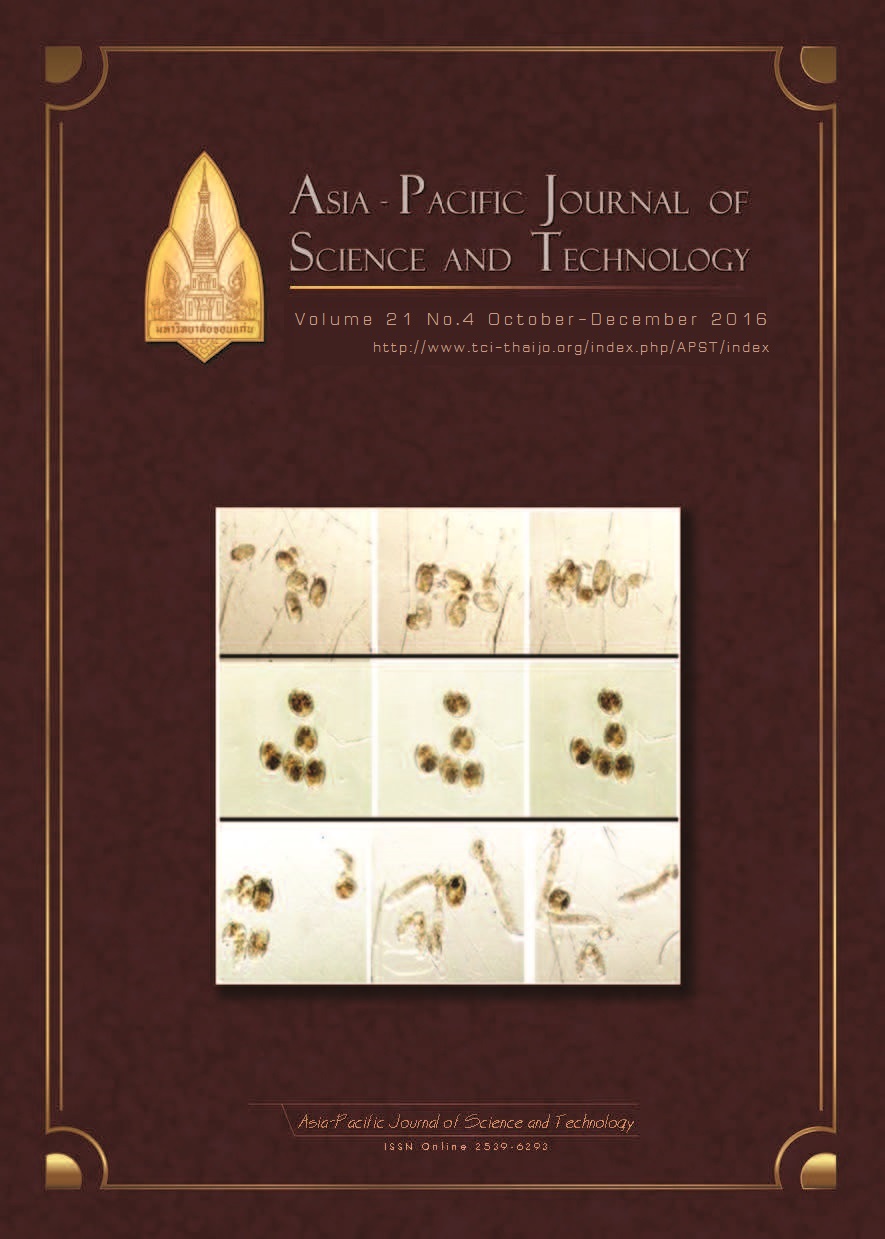Abilities of phosphate solubilizing bacteria isolated from sandy soils under rubber tree plantations of different ages in Northeast Thailand
Main Article Content
Abstract
In order to understand the impact of land use and the change which occurs within ecosystem services in rubber plantations, we must address the absence of knowledge on the influence of agricultural practices over biological processes within the soil. This study describes the results of phosphate solubilizing bacteria (PSB) isolated from soil from different ages of rubber tree plantations in Northeast Thailand; where soils are mainly sandy, and retain a P deficiency. PSB isolates were tested using different P sources [Tri-calcium Phosphate (Ca3(PO4)2) and Ferric Phosphate (FePO4)] on specific culture media [National Botanical Research Institute Phosphate Growth Medium, (NBRIP)] under controlled conditions. Our results indicate that PSB isolated from rubber trees of different ages (5, 11, and 22 years) solubilized significantly higher amounts (P 0.01) of FePO4 (601.45-631.63 mgP/L) and Ca3(PO4)2 (319.24-597.85 mgP/L). The highest activity of solubilization was achieved in FePO4, which is the main form of insoluble phosphates in acidic sandy soil. Indole acetic acid (IAA) production was also observed in different ages and locations of the rubber plantations. These results provide essential information for the influence of soil fertility within Thailand’s rubber plantations.
Article Details
References
[2] Antibus, R.K., Bower, D., Dighton, J., 1997. Root surface phosphatase activities and uptake of 32P-labelled inositol phosphate in field-collected gray birch and red maple roots. Mycorrhiza 7, 39-46.
[3] Chen, Z., Ma, S., Liu, L.L., 2008. Studies on phosphorus solubilizing activity of a strain of phosphobacteria isolated from chestnut type soil in China. Bioresource Technology 99, 6702-6707.
[4] Datta, C., Basu, P., 2000. Indole acetic acid production by a rhizobium species from root nodules of a leguminous shrub Cajanus cajan. Microbiological Research 155, 123-127.
[5] Gyaneshwar, P., Kumar, G.N., Parekh, L.J., Poole, P.S., 2002. Role of soil microorganisms in improving P nutrition of plants. Plant Soil 245, 83-93.
[6] Liphadzi, M.S., Kirkham, M.B., Paulsen, G.M., 2006. Auxin-enhanced root growth for phytoremediation of sewage-sludge amended soil. Environmental Technology 27, 695-704.
[7] Mohite, B., 2013. Isolation and characterization of indole acetic acid (IAA) producing bacteria from rhizospheric soil and its effect on plant growth. Journal of Soil Science and Plant Nutrition 13, 638-649.
[8] Mujahid, T.S., Subhan, S.A., Wahab, A., Masnoon, J., Ahmed, N., Abbas, T., 2015. Effects of different physical and chemical parameters on phosphate solubilizing activity of plant growth promoting bacteria isolate from indigenous soil. Journal of Pharmacy and Nutrition Sciences 5, 64-70.
[9] Murphy, J., Riley, J.P., 1962. A modified single solution method for the determination of phosphate in natural waters. Analytica Chimica Acta 27, 31-36.
[10] Mutluru, S., Mallaiah, K.V., 2007. Bioproduction of indole acetic acid by rhizobium strains isolated from root nodules of green manure crop, Sesbania Sesban (L.) Merr.” Iranian Journal of biotechnology 5, 178182.
[11] Nautiyala, C.S., 1999. An efficient microbiological growth medium for screening phosphate solubilizing microorganisms. FEMS Microbiology Letters 170, 265–270.
[12] Nuntagij, A., Abe, M., Uchimi, T., Seki, Y., Boonkerd, N., Higashi, S., 1997. Characterization of bradyrhizobium strains isolated from soybean cultivation in Thailand. Journal of General and Applied Microbiology 43, 183-187.
[13] Office of Agricultural Economics., 2012. [WWW Document]. URL http://www.oae.go.th/download/prcai/farmcrop/rubber52-54.pdf.
[14] Priyadarshan, P.M., 2011. Biology of Hevea Rubber. London. UK. 226 pp.
[15] Seangsanga, T., 2015. Biosynthesis of indole-3-acetic acid (IAA) of nitrogen fixing bacteria isolated from rubber tree Hevea Brasiliensis Mull-Arg. Proceeding the 7th national science research conference, March 30-31, Naresuan University.
[16] Son, H., Park, G., Cha, M., Heo, M., 2006. Solubilization of insoluble inorganic phosphates by a novel salt- and pH-tolerant Pantoea agglomerans R-42 isolated from soybean rhizosphere. Bioresource Technology 97, 204-210.
[17] Sungthongwises, K., 2012. Phosphate-Solubilizing Bacteria: An alternative to increase availability of phosphorus for Crop Production. Journal of Academic Services, Khon Kaen University 3-4, 15-24.
[18] Zahran, H.H., 1999. Rhizobium-legume symbiosis and nitrogen fixation under severe conditions and in an arid climate. Microbiology and Molecular Biology Reviews 63, 968-989.


